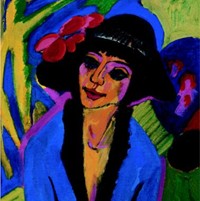Expressionist Portraits
German Expressionism Portraiture, Fauvist
Portrait Art in the 20th Century.
MAIN A-Z
INDEX
|
Expressionist Portraits |
 Portrait of Gerda (1914) Van der Heydt Museum, Wuppertal. By Ernst Kirchner, one of the great expressionist painters. Member of Die Brucke. |
Expressionist PortraitsIn general, 20th century artists were less interested in the classical hierarchy of genres, and more concerned with how to represent reality in an age of world war and moral uncertainty. Also, advances in photography and video made formal portrait art appear somewhat anachronistic. Even so, painters from a number of modern art movements included portraits in their repertoire. In the aftermath of Impressionism and Post-Impressionism, the two most important art movements to emerge at the beginning of the century, were Fauvism, and Expressionism. These two styles of painting were very similar, in that each downgraded the traditional emphasis placed on drawing - especially figure drawing - in favour of colour and overall impact. In general, unlike Impressionists, expressionist portrait painters did not seek to imitate or replicate nature. Instead, they sought to express their emotional response to what they saw, using garish colours, distorted forms and caricature-like imagery. See also: History of Expressionist Painting (c.1880-1930). |
Paul Guillaume, by Modigliani.
|
|
Georges Rouault: Self-Portrait (1911) Woman With a Hat (1905), by
|
Expressionist Portraiture "Expressionism" is a rather vague term which describes any style of art which distorts reality in order to convey a heightened awareness or sensibility of the subject. It is commonly used to refer to a group of early twentieth century German and other European painters, who moved beyond Fauvism in their bold (sometimes dramatic, even haunting) and garish portrayals of scenes and people. It embraces the three principal German Expressionist groups - the Dresden-based Die Brucke (the Bridge); the Munich-based Der Blaue Reiter (Blue Rider); and the post-war Die Neue Sachlichkeit - as well as certain artists of the Paris School (Ecole de Paris), such as Soutine, Rouault and Modigliani. Expressionist portraiture - which really began with the self portraits of Vincent Van Gogh and the Tahitian works by Gauguin (like Girl With A Fan, 1902) - is exemplified by: (1) the sensual Madonna (1894) by Edvard Munch; (2) the Fauvist portraiture of Henri Matisse and Andre Derain; (3) the bizarre series of silhouette style portraits by the self-destructive Austrian artist Egon Schiele, including: Self-Portrait Nude (1910), Portrait of Eduard Kosmack (c.1912), Portrait of Albert Paris von Gütersloh (1918); (4) the masterpiece Head of a Woman (1910) by Alexei von Jawlensky; (5) Portrait of Oscar Miestschaninoff (1923) and Portrait of Madeleine Castaing (1929) by the Jewish-Russian painter Chaim Soutine; (6) the decadent Portrait of the Journalist Sylvia von Harden (1926) by Otto Dix; (7) Woman in a Black Hat (1908) and Le Coquelicot (The Corn Poppy) (1919), by Kees van Dongen; (8) Portrait of Herwarth Walden (1910) and Portrait of Frau Reuther (1921), by Oskar Kokoschka; (9) the stained-glass-like portraits of Georges Rouault; and (10) the sublime portraiture of Modigliani (1884-1920). |
|
WORLD'S TOP PORTRAITURE CLASSIFICATION OF
THE ARTS |
The Expressionist Amedeo Modigliani Belonging to no art movement other than the Ecole de Paris, the tubercular poverty stricken drug-addict Amedeo Modigliani had a unique painting style which exhibited Expressionist, Cubist and Matisse-like tendencies. Renowned for his portraits and nudes, recognizable by their olive skins, elongated noses and necks, flat faces and almond-shaped eyes, Modigliani's early death at the age of 36 deprived the art world of a monumental talent. Among Modigliani's finest portraiture are the works: Portrait of Madam Pompadour (1915) Art Institute of Chicago; Portrait of Moise Kisling (1915) Private Collection; Portrait of Juan Gris (1915) Metropolitan; Bride and Groom (1916) MOMA, New York; Portrait of Leopold Zborowski (1916) Private Collection; Portrait of Jeanne Hebuterne (1918) Metropolitan Museum of Art; and Girl with Braids (1918) Nagoya City Art Museum. He also painted several portraits of his art dealer Paul Guillaume (1891-1934).
Abstract Expressionist Portraiture The term Abstract Expressionism denotes the modern American art movement which emerged out of the Second World War. Abstract and highly personal, its portraits were few and far between. One of the leading Abstract Expressionist figure painters was Willem de Kooning (1904-97), whose Woman series - begun by works like Seated Woman (1944, Metropolitan Museum of Art) - included Marilyn Monroe (1954). The next article covers Portraits by Picasso. |
|
• For more about the different types
of painting (portraits, landscapes, still-lifes etc) see: Painting
Genres. ENCYCLOPEDIA OF ART |